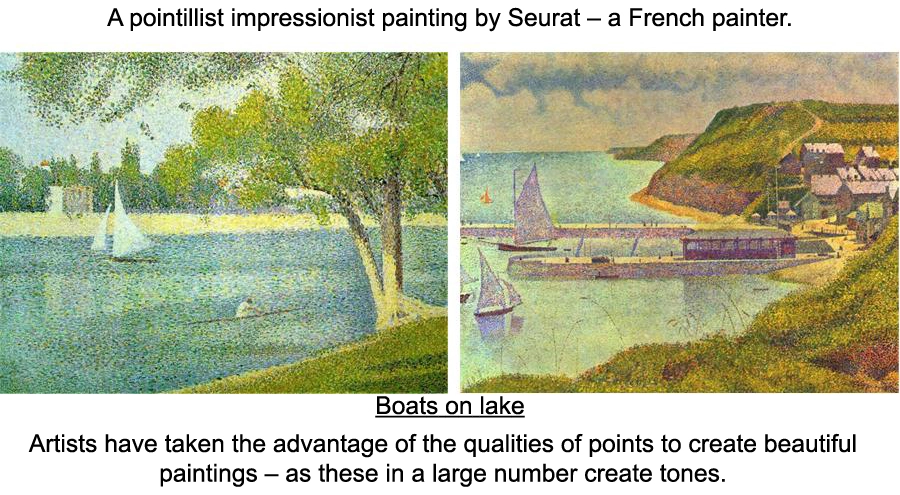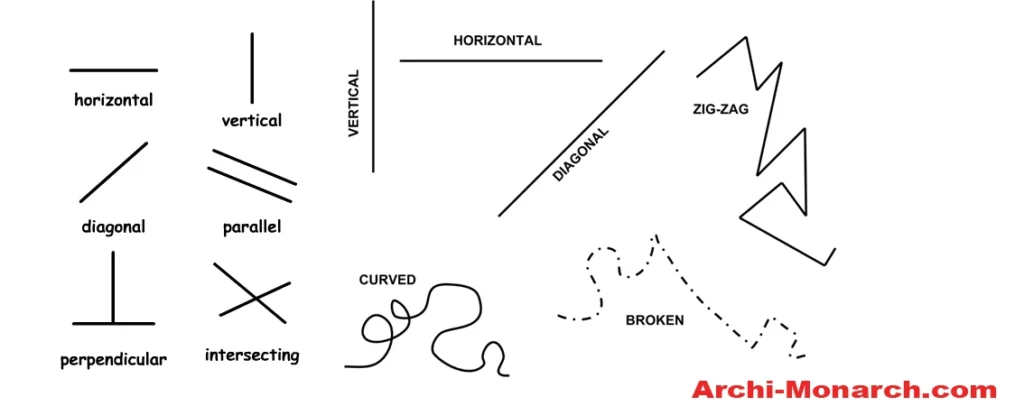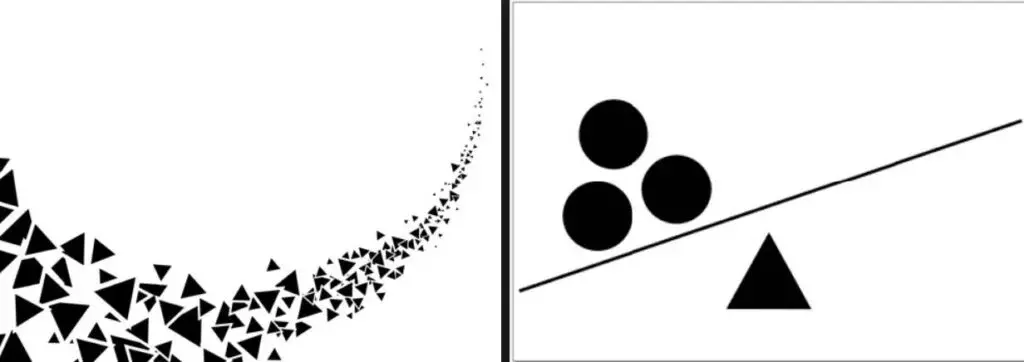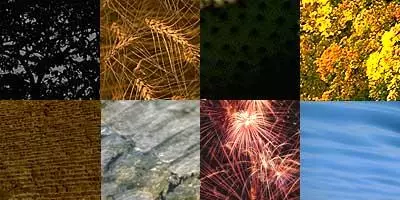“If you want to know about the principals of design or objective of design or origin of architecture, please click the link”
In architecture, the elements of design are used to create functional, visual composition and aesthetically pleasing structures. The elements are applied to both the interior and exterior of a building.
Visual composition starts with the basic elements: dot, line, shape, color and texture and subsequently the extended aspects of direction, movement, dimension and scale.
- The element of design are the basic building blocks of any composition.
- These items work along to make a unified composition and once utilized with success, produce a robust, dynamic visual layout.
- The designer uses these components as tools that management however a message is delivered to AN audience.
There are many types of elements of design described below…..
1) Point or dot
It has no length, width and depth and is therefore static, centralized and directionless.
- It indicates position in space.
- Adroitly, it has no length, width or profundity.
- It is static, concentrated and direction-less.
- As the prime component in the jargon of structure, it serves to check.
- It begins to make its presence felt when placed within a visual field.
- At the center of its environment, a dot is stable and at rest, organizing surrounding elements about itself and dominating its field.

- When the dot is moved off centre its field becomes more aggressive and begins to compete for visual supremacy.
- Visual tension is created between the dot and its field.

- The Dot is the simplest irreducible minimum unit of visual communication.
- Any dot has strong visual power to attract the eye wherever it exists naturally or is placed by artists in response to a purpose.
- Dots connect, and therefore are capable of leading the eye.
- In great profusion and juxtaposed, dots create the illusion of tone or color.

- Pointillism is a technique of painting in which a lot of tiny dots are combined to form a picture.

2) Line

When points are so close to one another that they cannot be individually recognized the sensation of direction is increased and the chain of dots become a distinctive Line. or Expansion of a point any headings know as line. To see well please experience underneath.
- A dot extended becomes a line.
- Paul Klee, the Swiss Expressionist painter, described a line as a dot out for walk.

- A line is a basic component in the development of any visual development.
- One of most significant components of configuration, line characterizes a subject’s structure or shape on a level, two-dimensional surface.
- Lines can be thick or dainty, smooth or rugged, unbending and mechanical or natural and hand drawn.
- The nature of a line can communicate mental qualities of a piece to a crowd of people.
- Although line has one dimension but it has some degree of thickness to become visible.
- It is seen as line because it’s length dominates it’s thickness.
i) A line can be
- A line can be – Taut or limp, Bold or tentative, Graceful or ragged.

- The character of a line is determined by our perception of it’s length-width ratio, contour and degree of continuity.
- Lines represent order and give the eye explicit directions about where to look and how to interpret what it sees.
- Lines can be straight or curved.
- Lines can be thick and thin.
- Just straight lines can be expressive by their direction.
- Horizontal – stability
- Vertical – ambition
- Angular – direction
| Horizontal | Stable, placid, Represents dignity, formality and strength. | |
| Vertical | Unstable, restless, ambitious, calm, peace and relaxation. |  |
| Angular | action, activity, excitement and movement. |  |
ii) Visual Construction
- A line is the critical element in formation of any visual construction.
- It can serve to:

- It can create texture and can be thick and thin. Types of line can include actual, implied, vertical, horizontal, diagonal and contour lines.

- Line can also be seen as a mark on a surface that describes a shape or outline.

- A line can also be seen as a form that has length and width but no depth. Lines are used to create edges and outlines of objects but by themselves can also be suggestive of visual expression. A line is created by the movement of a pen, pencil or brush.
- A line can define the outside contours of a shape, multiple lines can create value repeated lines can produce patterns.

The orientation of a line affects its role in visual construction
- Even the simple repetition of like or similar elements, if continuous enough can be regarded as line.

- This type of line has significant textural qualities.
Combination of lines can generate discernable or suggestive shapes.
Lines can make a statement by their direction
- Line defines the position and direction of the design. If you have lines or shapes that seem to be running horizontally, then the design would seem like it’s running in a left and right line.
- Make sure your design identifies some sort of line so that the human eye can recognize which side is the top of the design or on which side the design is suppose to start with interest.




- Lines are basic to all of the visual arts. Drawing is more or less based on using lines.

- The odd thing about lines is that they do not occur in nature.
- Line in art is an artificial device that we have learned to interpret as representing something. You have learned to read drawings with lines since childhood. The usual meaning of a line is that it represents an edge.
iii) How artists feel about lines

- Using a simple line to apply the principle of economy is to show only part of an image, giving enough information for viewers to complete it mentally.
- Lines are tools for communication. When an artist uses lines to define the edges of an object or to describe its surface they are like someone telling a story. A good story teller knows that it is not just the story, but the telling of it, that makes for success. The qualities of the lines in a drawing are like the timing, vocal inflections and emphasis that a story teller uses.
- Line quality also adds interest by increasing the variety in an image.
- Line quality describes the appearance of a line–its look not its direction. Different line qualities like thick, thin, light, dark, solid, broken, colored etc. all will change how the line is interpreted in a drawing.
This work by Bridget Riley’s Current is designed to interact by making us perceive optical effects that are not there. Current has the mystery of a figure-ground reversal: we can not be sure whether the design is black or white on black.
A combination of straight lines can convey different feelings.
See and absorb the difference
Straight lines can be modulated to create optical illusions
A few lines can generate associative mental images. Here, however, the line by itself loses its intrinsic meaning, as the ‘shape’ becomes more prominent.
iv) Tips on using lines
- Decide which part of your display is the most important, and direct attention to it by judicious use of line.
- Do not scatter lines about at random.
- Remember that margins are an in visible line.
- Attention to line does not mean that all elements in the design have to be lined up.
- By now you would have understood the strength and value of lines in design.
- Remember all your future work will be based on your appreciation of this element.
- Each line that you draw will have a meaning.
- So, do not waste or misuse this powerful element of visual design ( Element of design ).
3) Plane

- A plane is a flat, two-dimensional surface that extends in finitely far.
- A plane has length and width but no depth.
- In the composition plane serves to define the limit and boundary o fa volume.
- A line stretched out toward a path other than its regular heading turns into a plane.
- Thoughtfully, a plane has length and width, yet no profundity.
- The properties of each plane-size, shape, shading, surface just as their spatial relationship to each other eventually decide the visual characteristics of the structure, they characterize and the characteristics of room they encase.
Planes can be – FLATCURVED TWISTED
- Two parallel lines have the ability to describe the plane.
- A transparent spatial membrane can be stretched between them to acknowledge their visual relationship.

- Closer these lines are stronger the sense of plane.
i) Types of plane
In visual/ architectural design, there are three types of generic planes –
- Base plane
- Over head plane
- Wall plane
In architectural design, we control three conventional sort of planes
Base Plane

- The base plane can be either the ground plane that fills in as the actual establishment and visual base for building structures, or the floor plane that shapes the lower encasing surface of a room whereupon we walk.
Overhead Plane

- The overhead plane can be either the rooftop plane that protects the inside spaces of a structure from the climatic components, or the roof plane that frames the upper encasing surface of a room.
Wall Plane

- The divider plane, on account of its vertical direction, is dynamic in our ordinary field of vision and imperative to the forming and nook of design space.
4) Volume
- A plane stretched out toward a path other than its regular bearing turns into a volume.
- Adroitly, a volume has three measurements: length, width and profundity.
To see better, an investigation has been done and composed underneath.

- Focuses or vertices, where a few planes meet up.
- Lines or edges, where two planes meet.
- Planes or surfaces, which characterize the cutoff points or limits of a volume.
- Structure is the essential recognizing normal for a volume. It set up by the shapes and interrelationships of the planes that depict the limits of the volume.
- As, three-dimensional component in the jargon of building plan, a volume can be either a strong space uprooted by mass or a void-space contained or encased via planes.
5) Shape

- Shape is something that is seen as a separate entity from its surroundings within a visual composition.
- Shapes can be designed and are given different names like square, rectangle, circle, polygon, ellipse etc depending on the geometric properties of that the outline that define the shape.
- Shape is two dimensional with no form and does not have thickness. Shapes are flat.
- Shape can be seen as a self contained, defined area.
- A positive shape in a composition automatically creates a negative shape in the frame.
- Compositions are made in a frame and that too is a shape.
- A good composition is that in which shapes look good by themselves and relate well with other shapes in the composition and also the frame.
- Region encased when the two sides of a line meet. Shapes can be geometric or natural.
- A positive shape naturally makes a negative shape.

- Shapes are generally of two types:

- Given any composition of forms, we tend to reduce the subject matter in our visual field to the simple stand more regular shape.
- The simpler and more regular shapes are easier to perceive.
BESIDES THESE…….
- Some other type of shapes that we take a look are Abstract Shapes.
- Abstract shapes are shapes that have a recognizable form but are not “real” in the same way that natural shapes are.

Positive & Negative Shapes
Around the turn of the century, during the Industrial Revolution, rectilinear shapes were commonly seen in design and in fine art.
Art Nouveau and some Psychedelic art of the 1960s are two example so far tand design movements that use curvilinear shapes.
6) Form
Form is a 3-dimensional entity that has distinct volume and thickness. It can be generated as an illusion by using shading and lighting techniques. Form can be viewed from many angles.

- Form is the point of contact between mass and space.
- Form, texture, materials, modulation of light and shade, color, all combine together to give articulation to space.
- It may refer to an external appearance that can be recognized, as that of a chair or human body sitting over it.
- Form suggests reference to both internal structure and external out line and the principles that gives unity to the whole.
- It includes sense of three dimensional mass and volume.
- Form is the three-dimensional advancement of a two-dimensional shape. For instance, a 2D shape like a circle could be transformed into a 3D form like a circle.
- In most visual computerization, the expansion of a third measurement is a hallucination since we are as yet chipping away at a two-dimensional work of art.
- Essential forms are three-dimensional figures, including circles, solid shapes, chambers, pyramids and cones. On the off chance that an item has tallness, width and profundity, it is a form.
- A form can take care of business made, mathematical shape that is numerically exact in the entirety of its points and edges, or it very well may be a characteristic, natural form.
i) Properties of form
Form have relational properties which governs the pattern and compositions of elements as:
- Position: is location of form relative to its environment.
- Orientation: is direction of a form relative to the ground plane.
- Visual inertia: is degree of concentration or stability of form.
ii) Primary forms
- Cubes, cones, sphere or cylinders are the great primary forms.
- The primary shapes can be extended or rotated to generate volumetric forms.
iii) Transformation of form
- Dimensional transformation: A form can be transformed by altering one of its dimension and still retaining its identity as the member of family of solids.

- Additive transformation: a form can be transformed by addition of elements to its volume.

- Subtractive transformation: A Form can be transformed by subtracting a portion of its volume.

7) Space
It is a continuous area or expanse which is free, available, or unoccupied. It is the area in which everything is arranged. The area around, within or between images or elements. An element of art by which positive and negative areas are defined or a sense of depth achieved in a work of art. It is the distance or area around or between elements in a work.

- Space has to be included in any visual design.
- In 2-dimensional arrangements space means leaving some blank are as in a composition.
- A human eye needs space to feel comfortable, and space will let the eye distinguish the part that’s meant to be noticed compared to just the background.
- Some times not including space in a visual design is acceptable, but care has to be taken to as certain that the final visual effect is not over crowded and chaotic.
- Space gives depth and dimension and is in front of or behind objects, around them, or projecting from them.
- Space adds interest, excitement, and contrast to a visual design.
- Any shape that overlaps an other seems to be in front of it and warm colors seem to be in front of cool ones in the total space of the composition.
- Any thing which adds depth or the appearance of depth will enhance the display.
- Space can be used to separate or group information – It could be used effectively to: give the eye a rest define importance lead the eye through a design

- Any three-dimensional article which can be molded/framed for human home can be called as space.
- Engineering plans are made via cutting and making space out of space and planning spaces by partitioning this space utilizing different instruments, for example, math, tones, and shapes.
Space is positive or negative
- Positive space is where shapes and forms exist.
- Negative space is the empty space around shapes and forms.
- For images to have a sense of balance positive and negative space can be used to counter balance each other.
The appearance of space can be created in various ways. Positive space is represented by a highlight or an object and negative space is open or shaded.
- Space constantly encompasses our well being.
- The qualities of visual form, dimension and scale, light, etc depends on our perception of spatial boundaries.
- As space begins to be captured, enclosed, molded and organized by the elements – mass comes in to being.
- Space is the glue that holds all design together.
- Space is the “ground” in which a form becomes a “figure”
8) Size
- Size is simply the relationship of the area occupied by one shape to that of another.
9) Direction
Compositions can have direction – Horizontal, Vertical or Oblique. Horizontal suggests calmness, stability and tranquility. Vertical gives a feeling of balance, formality and alertness. Oblique suggests movement and action. The composition could be centered and still too.

- A course along which a person or thing moves.
- Direction gives the deception of development inside a plan.
- Level recommends serenity, soundness and quietness.
- Vertical gives a sensation of equilibrium, convention and readiness.
- Diagonal recommends development and activity
i) Direction movement

- Directional Movement is a visual flow through the composition.
- It can be the suggestion in a visual design as the eye moves from object to object by way of placement and position.
- Directional movement can be created with the placement and size of shapes used in a composition.
- It is also with the placement of dark and light are as that attention can be moved through a composition.
10) Texture
Texture refers to the quality of a surface. Everything that has a surface has texture. There are two kinds of texture:
- Tactile touch 3D texture
- Visual illusion 2D texture

- Texture – is about surface quality either tactile or visual.
- Texture can be real or implied by different uses of media.
- It is the degree of roughness or smoothness in objects.
- Texture is the surface quality of a shape – rough, smooth, soft hard glossy etc.
- Texture can be physical (tactile) or visual.
- The vibe, genuine or suggested, on an item or its surface.
- Texture is the surface nature of a shape – harsh, smooth, delicate hard shiny and so on.
i) Visual texture
- Visual texture refers to the illusion of the surface’s texture.
- It is what a surface looks like.
- The textures seen in a photograph are visual textures.
- No matter how rough objects in the photograph look, the surface of the photograph is smooth and flat.
- Texture is a surface quality.
- It relates to the appearance of a surface.
- Appearance can be perceived by either the eyes or touch.
- Surfaces can look or feel smooth, rough, soft, cool, or warm.
- They can look pleasant or unpleasant, which can have a dramatic effect on a display.

Texture in Everyday Life
- Textures range from the smoothest polished mirror to the roughest sandpaper like surface. The term is often misused to refer only to rough surfaces but this is not correct. All surfaces have texture.
- A designer recognizes that different textures can affect interest in different ways.
- Some surfaces are inviting and some are repellent and reaction is normally created by texture or color.
- Using different textures can increase interest in a composition by adding variety without changing color.

- Visual texture is always a factor in a composition because everything has a surface and hence a texture.
- Plain paper has a boring texture that is only slightly different from the note book’s paper.
- Some other colored papers are more visually interesting. This is because of their color, but also their texture.
- Look around to see what interestingly textures (both visual and tactile) can be seen.
11) Pattern

- Patterns also create textures.
- A recognizable motif regularly repeated produces a pattern. Pattern requires repetition–in design as in life (a pattern of behavior). The more regular the repetition, the stronger the pattern. Compare this field of flowers with a checker board. Both have a repeating motif.
- All of the motifs in a pattern have surfaces, so there is always texture. But there is not always pattern–only when you notice it.

- Texture and pattern are related. When you look closely at a tree you can see the pattern of leaves that make its surface.
- When you back a way you loose awareness of the leaves and notice the texture the leaves make on the tree.
- Farther away still and you can see the pattern of the trees making up the forest and finally the texture of the forest.
- In this way pattern changes to texture as you loose sight of the individual motifs. This is easy to do with natural patterns, but you have to get quite far away from a checker board grid to see it as texture.

- Patterns are generally more noticeable than textures. This makes them a stronger visual element for controlling attention.
12) Colour
Color refers to specific hues. It has 3 properties:
- Hue – Spectral color name
- Intensity Or saturation is concerned with the brightness or dullness of a color
- Value – Relative darkness or lightness of a color
- Color wheel is a way of showing the chromatic scale in a circle using all the colors made with the primary triad.
- Black and white can be added to produce tints (by adding white), shades (by adding black) and tones (by adding gray).

- Colour or color is a property of light as seen by people. The aspect of any object that may be described in terms of hue, lightness, and saturation.
- In physics, colour is associated specifically with electromagnetic radiation of a certain range of wavelengths visible to the human eye.
There are three different types of colours: primary, secondary, and tertiary colours.
- Primary Colour – Yellow, Red & Blue.
- Secondary colours – Green, Orange and Violet.
- tertiary colours – Yellow-orange, red-orange, red-Violet, blue-Violet, blue-green, and yellow-green.
13) Value
- Design values are standards or convictions that are received by a designer to manage their work. Design values might be related with a style or sort of design. On the other hand, they might be special to a firm or individual designer.
The effective use of these elements can greatly enhance the visual appeal, functionality, and cultural significance of a building.











Thanks. This is an excellent article.